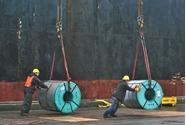Shipping and Logistics

Crisis in Dry Bulk Shipping Market
Written by Sandy Williams
February 2, 2016
The latest MID-SHIP Report reiterates the crisis in the shipping industry calling it “the most significant depression in dry bulk shipping since the mid-1980’s.” The Baltic Dry Index, which tracks shipping rates for dry bulk cargos like iron ore, coal and grain, peaked in May 2008 with an index reading of 11,793 and fell to 663 by December of 2008. By November 2009 the market recovered reaching an index reading of 4643. Infused by new optimism, vessel owners rushed to increase the size of their fleets.
The economic slowdown in China, decreased global demand, and falling fuel and energy costs put shipping rates in free fall, reaching an all-time low of 314 on February 1, 2016. Stuck with an excess vessel supply shipping companies are now faced with significant financial losses and are scrambling to stay afloat, literally.
Fleet growth flattened in 2015 due to significant scrapping of vessels, but MID-SHIP says Cape Size vessels are set increase by as much as 180 ships in 2016, while more than 240 deliveries of Panamax ships are expected. Handymax growth continued in 2015, increasing fleet size in the range of 5.5 to 6.25 percent. More than 440 new Handymax vessels are scheduled for delivery in 2016.
Owners are turning to ports authorities for lay-up requests with AIS data indicating more than 300 dry bulk ships have been immobile for one month and another 300 for two weeks. MID-SHIP notes lay-ups are “an artificial way of removing tonnage from the industry.”
“Much like slow steaming (which at present fuel prices is less necessary), laid-up tonnage represents a level of supply that is hidden from the effective trade and threatens to re-appear as soon as rates improve, hence keeping a lid on earnings.”
The challenges in the aluminum and steel industry have caused production cuts that have dramatically impacted coal and iron shipments, further aggravating seaborne shipping conditions.
“Looking forward, we expect the freight market in 2016 to be similar to what we have experienced in 2015,” said MID-SHIP. “Cargo demand in the major and minor bulks being steady to up slightly and the aforementioned oversupply of vessels tempered by continued scrapping and increased layup of vessels.”
“While we do not expect to be popping any champagne corks any time soon and rather staying sober, working hard for our clients, we feel we are at or near the bottom and remain hopeful of some small improvement in freight rates in the coming months, likely in the second half of 2016.”

Sandy Williams
Read more from Sandy WilliamsLatest in Shipping and Logistics

US Great Lakes iron ore cargoes down notably through May
The Lake Carriers' Association reported a considerable decline in monthly iron ore shipments from US ports on the Great Lakes.

Wittbecker: West Coast port congestion
What's going on in West Coast ports?

Wittbecker: Mexico invests in port capacity despite US tariff troubles
The Mexican government aims to transform Manzanillo into the largest seaport in Latin America, capable of processing some 10 million TEU (20-foot equivalent units) per year by 2030. It is already Mexico's largest port and the third largest in Latin America, handling nearly 4 million 20-foot containers in 2024.

Wittbecker on Aluminum: When do the tariffs reach Main Street?
Containers sailing from China in April are down 15%-20% and Hapag Lloyd says their future bookings transpacific are down 30%.

Wittbecker on Aluminum: US-China trade war clobbers cross-Pacific trade
Container shipping lines have sharply increased blank sailings on Transpacific routes in response to escalating trade tensions between the US and China.
